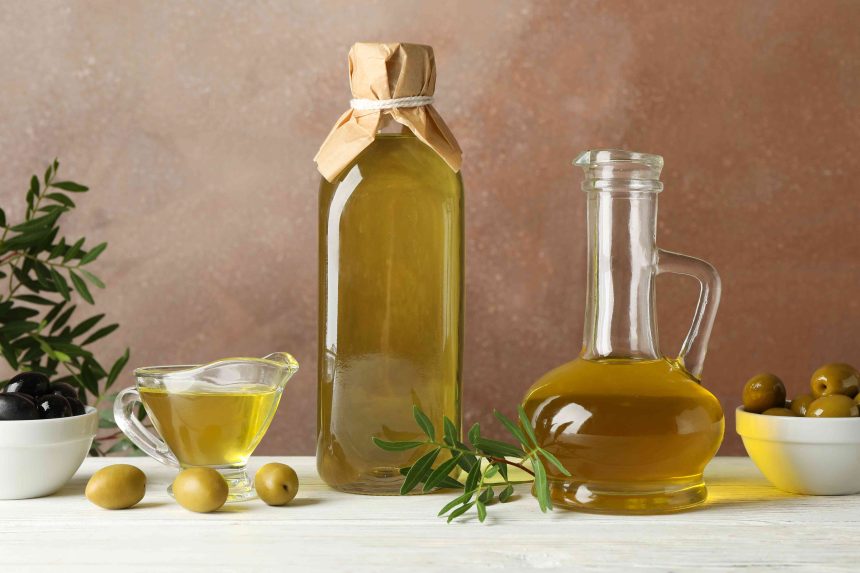There’s a lot of chatter around olive oil. Rightfully so—it’s a staple in the Mediterranean diet, and it’s considered one of the healthiest cooking oils. However, it’s not the most commonly used oil in the United States. That title belongs to soybean oil, the most popular vegetable oil. Most products labeled “vegetable oil” are actually 100% soybean oil, though vegetable oil can also refer to canola oil, rapeseed oil, and others.
If you’re an olive oil enthusiast, you may wonder: Can you use olive oil instead of vegetable oil? Here’s what you need to know about these different oils, and whether they’re interchangeable.
- Emily Lycopolus, olive oil critic and the author of Olive Oil and Vinegar Lovers Cookbook
- Ersilia Moreno, olive oil expert and the owner of Olive Oil of the World in North Palm Beach, Florida
- Keiry Palma, a professional baker and instructor at the Institute of Culinary Education in New York City
What Is Vegetable Oil?
If “vegetable oil” sounds broad, that’s because it is—it’s used as a shorthand term to describe numerous oils derived from plants. Vegetable oils can include a variety of plant-based oils, including canola, grape seed, sunflower, corn, and others, though soybean is the most common.
Since olive oil is derived from, well, olives, and olives are technically a fruit, vegetable oil and olive oil are two distinctly different products.
Olive Oil vs. Vegetable Oil: What’s the Difference?
Both are common oils, but they’re not the same. “The difference between olive oil and vegetable oil is significant,” says Emily Lycopolus, author of Olive Oil and Vinegar Lovers Cookbook. Here’s how they differ.
Processing
You can think of virgin olive oil (VOO) and extra virgin olive oil (EVOO) like fresh fruit juice, Lycopolus notes. Neither chemicals nor heat are used to make VOO and EVOO—they’re mechanically extracted to retain their flavors and nutrients. Made from a singular ingredient—olives—olive oil has been around for thousands of years.
Vegetable oil, on the other hand, is highly refined. “Vegetable oils must be chemically extracted and bleached to make them edible and fit for human consumption,” Lycopolus explains. This makes vegetable oil a highly processed food, and one that hasn’t been around for as long. The vegetable oil used today was introduced less than 200 years ago.
Nutrition
It’s no secret that olive oil has many nutritional benefits. When researchers compared it to 31 other edible oils, VOO earned a perfect score and came out on top as the most nutritious option. Rich in monounsaturated fatty acids (MUFAs), olive oil is known for providing plenty of healthy fats. It’s also a potent source of antioxidants known as polyphenols, which may help lower the risk of certain diseases, research shows.
Vegetable oil is often touted as a heart healthy alternative to butter and margarine, given its lower saturated fat content. Soybean oil has even been linked to lower cholesterol levels and reduced risk of heart disease. However, it’s not as nutritious as olive oil because it contains fewer beneficial fatty acids and antioxidants.
Flavor
“Olive oil has a distinct flavor that often adds depth and richness,” says Ersilia Moreno, owner of Olive Oil of the World. “Olive oil doesn’t just add fat—it enhances the flavor of the food and makes it better,” she adds. The flavor of olive oil can vary depending on the variety and quality of the oil, which is important to note since olive oil imparts flavor onto food. “Some are bitter and spicy, some are buttery, and some are even tropical in flavour,” Lycopolus says.
Vegetable oil is known for its neutral flavor. “While it doesn’t offer the same richness as olive oil, its neutrality can come in handy when you want the flavor of other ingredients to shine through,” explains Keiry Palma, an instructor at the Institute of Culinary Education.
Smoke Point
A smoke point is exactly what it sounds like—the point at which an oil turns to smoke. It matters because this is when an oil starts to break down, producing potentially harmful compounds in the process.
EVOO has a smoke point between 350 and 410 degrees Fahrenheit, according to the North American Olive Oil Association.
Vegetable oil has a higher smoke point—up to 450 F. Since it’s suitable for cooking over medium to high heat, as well as lower heats, some argue that vegetable oil is more versatile.
Can You Use Olive Oil Instead of Vegetable Oil When Cooking?
Olive oil is commonly used in salad dressings and other raw preparations, but can you cook with it? You certainly can, according to Moreno. “Olive oil is so versatile that it goes across the board of culinary uses,” she says, clarifying that yes, you can sauté and roast with it. You can even deep-fry with olive oil because it doesn’t burn, and further enhances the flavor of fried foods, she notes. The right temperature for frying is between 325 and 375 F.
If you’ve been told that olive oil is best reserved for cooking at lower temperatures because it has a low smoke point, you may be cautious to cook with it. The concern is that high temperatures render olive oil unstable and destroy some of its beneficial properties. “This is the number one myth about olive oil,” Lycopolus says, adding that you can cook with olive oil over high heat. “EVOO is incredibly stable, and has a heat tolerance of about 400 F,” she explains.
Using olive oil instead of vegetable oil in cooking can positively affect the flavor and nutritional profile of your dish too. “Olive oil has a wide range of flavors, and can really enhance a recipe,” says Lycopolus. Given its healthy fats and antioxidants, it can also give your dish a boost in nutrients, Moreno points out.
Can You Use Olive Oil Instead of Vegetable Oil When Baking?
“You can absolutely, 100%, bake with olive oil,” Moreno says. Whether you’re following a recipe for a boxed mix or baking from scratch, olive oil is perfectly suitable. Just make sure the recipe calls for liquid fat, Moreno notes.
But what about the intense flavor of olive oil in baked goods? You can use it to your advantage. “The distinct, fruity flavor of olive oil adds complexity to baked goods, unlike the neutral flavor of fats like butter and vegetable oil,” Palma shares. It even pairs well with certain flavors in desserts, such as chocolate. “[Olive oil] takes chocolate to the next level with its moistness and richness,” Moreno adds, noting that it is perfect for brownies and chocolate cake.
Olive oil also contributes to the texture of baked goods. “With olive oil, you can make moist, slightly dense, and tender cakes,” Palma says. “It’s also great for quick breads, cookies, and savory baked goods, like focaccia, pizza, and quiche.”
However, the reverse isn’t necessarily true: “You shouldn’t use vegetable oil in place of olive oil because you could miss out on key flavors, and your dish may taste like it’s missing something,” shares Lycopolus.
What Ratio Is Best?
When using olive oil in place of vegetable oil, you can generally follow a 1:1 ratio, Moreno notes. So, one cup of vegetable oil would become one cup of olive oil. However, there may be times when less olive oil is needed compared to vegetable oil, due to the differences in flavor. “Consider reducing the amount of olive oil slightly, as its flavor can be more intense than neutral vegetable oil,” Palma suggests.
Which Oil is Best?
“The best oil to use is EVOO,” Moreno says. “It’s not processed with heat or chemicals, provides an abundance of nutrients, and contributes a rich flavor to any recipe,” she adds. When you have a good olive oil on hand, you don’t necessarily need any other oil, according to Moreno. Her final word of advice? “Choose a quality olive oil and use it up while it’s fresh—that’s what it’s meant for.”





